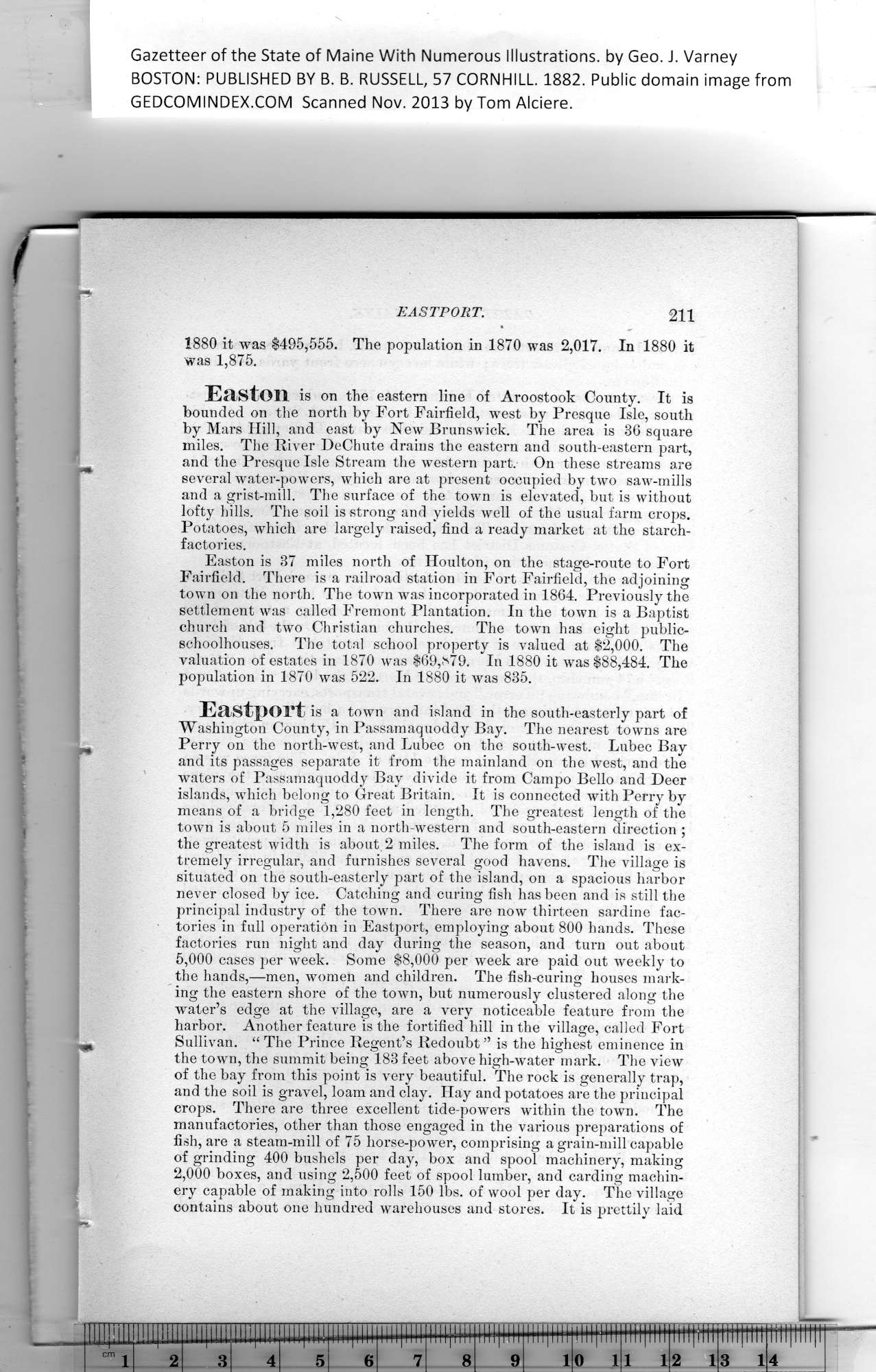|
Gazetteer of the State of Maine With Numerous Illustrations, by Geo. J. Varney
BOSTON: PUBLISHED BY B. B. RUSSELL, 57 CORNHILL. 1882. Public domain image from
EASTPORT. 211
1880 it was $495,555. The population in 1870 was 2,017. In 1880 it
was 1,875.
Easton is on the eastern line of Aroostook County. It is
bounded on the north by Fort Fairfield, west by Presque Isle, south
by Mars Hill, and east by New Brunswick. The area is 36 square
miles. The River DeChute drains the eastern and south-eastern part,
and the Presque Isle Stream the western part. On these streams are
several water-powers, which are at present occupied by two saw-mills
and a grist-mill. The surface of the town is elevated, but is without
lofty bills. The soil is strong and yields well of the usual farm crops.
Potatoes, which are largely raised, find a ready market at the starch-
factories.
Easton is 37 miles north of Houlton, on the stage-route to Fort
Fairfield. There is a railroad station in Fort Fairfield, the adjoining
town on the north. The town was incorporated in 1864. Previously the
settlement was called Fremont Plantation. In the town is a Baptist
church and two Christian churches. The town has eight public-
schoolhouses. The total school property is valued at $2,000. The
valuation of estates in 1870 was $69,879. In 1880 it was $88,484. The
population in 1870 was 522. In 1880 it was 835.
Eastport is a town and island in the south-easterly part of
Washington County, in Passamaquoddy Bay. The nearest towns are
Perry on the north-west, and Lubec on the south-west. Lubec Bay
and its passages separate it from the mainland on the west, and the
waters of Passamaquoddy Bay divide it from Campo Bello and Deer
islands, which belong to Great Britain. It is connected with Perry by
means of a bridge 1,280 feet in length. The greatest length of the
town is ahout 5 miles in a north-western and south-eastern direction ;
the greatest width is about 2 miles. The form of the island is ex-
tremely irregular, and furnishes several good havens. The village is
situated on the south-easterly part of the island, on a spacious harbor
never closed by ice. Catching and curing fish has been and is still the
principal industry of the town. There are now thirteen sardine fac-
tories in full operation in Eastport, employing about 800 hands. These
factories run night and day during the season, and turn out about
5.000 cases per week. Some $8,000 per week are paid out weekly to
the hands,—men, women and children. The fish-curing houses mark-
ing the eastern shore of the town, but numerously clustered along the
water’s edge at the village, are a very noticeable feature from the
harbor. Another feature is the fortified hill in the village, called Fort
Sullivan. “ The Prince Regent’s Redoubt ” is the highest eminence in
the town, the summit being 183 feet above high-wrater mark. The view
of the bay from this point is very beautiful. The rock is generally trap,
and the soil is gravel, loam and clay. Hay and potatoes are the principal
crops. There are three excellent tide-powers within the town. The
manufactories, other than those engaged in the various preparations of
fish, are a steam-mill of 75 horse-power, comprising a grain-mill capable
of grinding 400 bushels per day, box and spool machinery, making
2.000 boxes, and using 2,500 feet of spool lumber, and carding machin-
ery capable of making into rolls 150 lbs. of wool per day. The village
contains about one hundred warehouses and stores. It is prettily laid
PREVIOUS PAGE ... NEXT PAGE
This page was written in HTML using a program written in Python 3.2
|
